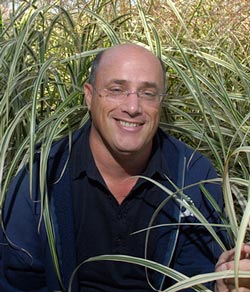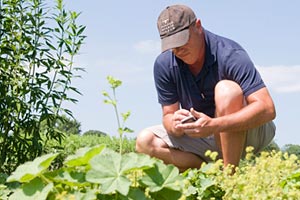Plant Evaluation Manager for the Green Roof Garden

The Chicago Botanic Garden’s 16,000-square-foot Green Roof Garden is atop the Daniel F. and Ada L. Rice Plant Conservation Science Center, which opened in 2009. The garden consists of the Ellis Goodman Family Foundation Green Roof Garden South and the Josephine P. & John J. Louis Foundation Green Roof Garden North.
Q: How do you feel about the Green Roof Garden now that it’s five years old?
Hawke: I continue to be impressed and excited by how the green roof has prospered and evolved over the past five years. It is a truly beautiful garden, a dynamic landscape, and a valuable research project.
Q: What did you hope would grow that did not?
Hawke: I was a little surprised that some of the drought-tolerant plants such as sulfur flower (Eriogonum umbellatum) and tufted fleabane (Erigeron caespitosa) didn’t do better on the green roof. I also thought long-petaled lewisia (Lewisia longipetala 'Little Plum') would be a stronger plant than it was.
Q: What grew well that you expected to fail?
Hawke: Although I didn’t expect it to fail, I also didn’t expect the wild white indigo (Baptisia alba var. alba) to be as large and vigorous as it has become. By year five it was an elegant plant nearly 3 feet tall with dramatic spires of white flowers.
Q: What happens next in the Green Roof Garden?
Hawke: Keeping the goal of compiling a broad list of good plants for green roofs in mind, we’ll continue to add new plants into the evaluation plots beginning in 2015. I plan to increase the replication of trials in 4- , 6- and 8-inch soil depths. And we continue to compile a list of potential plants, both native and nonnative species, for testing on green roofs.
Q: What happens to the plants that succeeded?
Hawke: Plants that succeed in the evaluation trials will be integrated continually into the green roof display areas. To date, we have already moved pussytoes (Antennaria dioica), bluebell (Campanula rotundifolia), lanceleaf coreopsis (Coreopsis lanceolata), and arrowleaf violet (Viola sagittata), from the trials into the display. Other top performers planned for display include lakeside daisy (Tetraneuris herbacea), silky prairie clover (Dalea villosa), and blue sage (Salvia azurea var. grandiflora). It’s exciting to think about how spectacular the roof garden will look as we add new plants and make new plant combinations.
Q: What was the biggest surprise?
Hawke: I don’t want to sound too simplistic, but the biggest surprise was that the green roof survived as well as it did! I was blown away by the survival rates among plants, but more importantly by the fact that so many of the plants thrived and even excelled in this challenging landscape.
Q: What was the biggest disappointment?
Hawke: I’m not happy that we haven’t been able to establish sundial lupine (Lupinus perennis) on the green roof, although we planted it again this past spring—maybe the third time will be the charm. In a broader sense, I’m disappointed we haven’t had greater success with more plants in the 4-inch depth. We know that a shallow depth is the most challenging area on the green roof, so we’ll strive to add more types of plants to this trial area in the coming years.
Q: What did you learn that you did not know?
Hawke: It was all theoretical when we started in 2009, so I’ve learned a lot along the way. It’s been amazing to watch the plants grow and communities form. This experience has reaffirmed for me that plants can be extremely adaptable and resilient despite adverse conditions.
Q: What would you do differently next time?
Hawke: I would have more replicated trials from the start. Planting a specific plant in all three growing depths increases our knowledge about the appropriate depth for best growth of the species.
Q: Is there a roof garden plant that you consider the most elegant of all?
Hawke: I was particularly taken with meadow blazing star (Liatris ligulistylis)—a pretty fall-bloomer with flower stems nearly 2 feet long and a magnet for monarch butterflies. But I also think prairie dropseed (Sporobolus heterolepis) was an absolute standout on the green roof. Its fine-textured foliage and graceful arching habit look good all year in all growing depths, and the fragrant flowers make the roof smell like popcorn in August and September before the plant ultimately turns orange in the fall.
Q: What are the five things you would tell someone who is thinking of starting a rooftop garden?
Hawke:

- Think about what you want the green roof to accomplish. Is it for economical and environmental reasons only, or are you also looking to have a pleasing garden? An extensive green roof is more utilitarian with a less diverse plant palette than an intensive type, which has a deeper growing medium that supports more types of plants.
- Whether you're building new or retrofitting an existing building, engage a structural engineer right away to determine the structure’s suitability and viability.
- Keep in mind that a green roof (regardless of the type) is not simply a garden or landscape elevated to the top of a building. Choosing the right plants is essential to a successful green roof.
- Check green roof literature, websites and blogs for the best information on plants for your region and the type of green roof you're planning. Our Plant Evaluation Notes on green roof plants is the perfect place to start locally.
- If you’re planning a semi-intensive system (greater than 6 inches of growing depth) with a broad diversity of plants, then plan for roof access to maintain the plantings.
Richard Hawke is the plant evaluation manager and an associate scientist at the Chicago Botanic Garden. His main research is the comparative evaluation of ornamental plants, predominately herbaceous perennials, to determine the best garden plants for the Upper Midwest and areas with similar climatic conditions.

